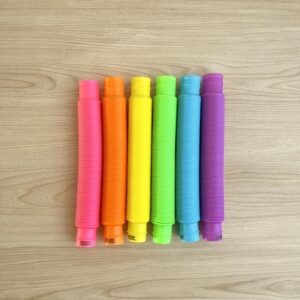I was at a meeting the other night where we discussed pop tubes and other small instruments that kids love. Pop tubes have been trending as a fidget tool for several years now, and they’ve graced many elementary music classrooms as a tool for reading rhythms. So, I was inspired to write a blog post about how to use pop tubes for teaching musical pitch.

High and Low Pitches (stretching & squishing)
Have students stretch the tubes as long as they’ll go and tell them to observe the sound it makes. Ask them leading questions such as, “What happens to the pitch when you stretch it out really long?” or “How does it sound when you slowly squish it back together?”
Ideally, your students will notice that the pitch gets lower the longer the tube is, and the pitch gets higher the shorter the tube is. You can expand on this idea by discussing other long and short instruments (like Boomwhackers™ and hand chimes) and the sounds that they make. The pop tubes will function like Boomwhackers™, but that activity is best tried with students who won’t whack the pop tube into a pancake.

Twirling & Stacking
Begin by stretching out a tube as far as it will go, then twirling it in a circle as fast as you can. You’ll hear a high-pitched whistling sound. Next, attach another stretched out tube to the original, and spin it again. Your students should notice that the whistle has dropped in pitch because the tube is longer. You can continue to perform this experiment with as many tubes as you can stack and twirl (I could only manage three). If students want to try this (and they will) only give them one pop tube at a time and remind them to stay inside their personal bubble. Otherwise, you’ll have front row seats to some colorful lightsaber battles.
Vocal Exploration
This activity is by far the easiest, can be used at any grade level, and would be fantastic for centers. Simply have your students create shapes with their pop tubes and then sing the melodic direction of those shapes. If you have an open house night or celebrate the arts event coming up, this would be a great activity to have as part of your stations. You can read more ideas for that HERE.

